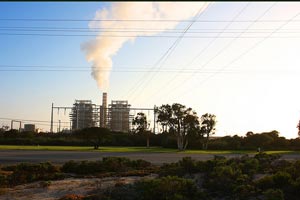
Flickr/<a href="http://www.flickr.com/photos/tomsaint/" target="_blank">Rennett Stowe</a>
The federal government is giving a joint venture involving oil giant BP millions of dollars in stimulus money to build a power plant on farmland near the tiny Kern County town of Tupman, even as the company faces heavy government pressure and a criminal probe into the Gulf of Mexico oil spill.
BP is benefiting from a $308 million federal grant over several years for the cutting-edge power plant on cotton and alfalfa fields seven miles from the western edge of Bakersfield. More than half of the money, $175 million, is coming from stimulus funds. The rest is coming from another federal program.
The stimulus portion alone ranks as the second biggest award in California to a corporation and among the largest in the country benefiting private interests, according to data reported to the government by stimulus recipients.
The US Department of Energy announced the grant last year to Hydrogen Energy California, a joint partnership of BP and the multinational mining firm Rio Tinto, and has paid out $13.6 million so far. The money continues to flow even as the Obama administration bills BP for the massive costs of the oil spill.
“If you’re trying to get money out of them, why are you giving them money?” said Tom Frantz, a local environmental advocate and part-time almond farmer who opposes the power plant. “If I was the government right now, I would not give BP $300 million to do anything.”
The stimulus award highlights the disconnect that occurs when the government gives grants and contracts to companies it has fined or prosecuted. BP, for example, had been fined hundreds of millions of dollars and pleaded guilty to criminal environmental violations before the Gulf spill and before receiving stimulus money.
The involvement of BP in this stimulus project also poses a sticky political calculus, pitting anger at BP against the desire to create jobs and advance alternative energy. The White House and some congressional critics of BP also support “clean coal” projects like the one this stimulus money will advance.
Critics of the stimulus bill, Sens. John McCain, R-Ariz., and Tom Coburn, R-Okla., issued a report Tuesday that highlighted the Hydrogen Energy plant as one of 100 stimulus projects that waste taxpayer money, stating “BP may have found itself staring down huge financial losses over the past several months, but executives can take solace knowing that a stimulus windfall will help offset them.”
The grant appears to be the only significant stimulus award for BP. A review of the $219 billion in stimulus funds awarded nationwide did not turn up any other major grants to the company. A spokeswoman for the power plant partnership distanced the project from BP.
“Most people understand that Hydrogen Energy California LLC, and not BP, is the entity that received a DOE (Department of Energy) grant after a competitive solicitation that was conducted, evaluated and awarded in 2009,” Tiffany Rau wrote in an e-mail. “DOE reimbursements provide cost sharing in HECA’s (Hydrogen Energy California’s) expenses—no money is flowing to BP.”
Hydrogen Energy California is a 50/50 partnership owned by BP and Rio Tinto and registered to a BP address. The project’s manager, as well as Rau, came to the project from BP. At a public hearing last fall, when a local landowner asked about potential disasters the plant could cause, Gregory Skannal, who worked at BP before becoming the project’s health, safety, security and environmental manager, addressed the question: “One of our parent companies is BP,” he said. “And in that same vein, we do have resources internal to the company that provide security assessments. And those are the resources that we will be relying on in supporting us and doing those assessments to determine vulnerabilities, security measures and consequences.”
BP declined to comment for this story, but departing CEO Tony Hayward had stated in 2007, when announcing the joint venture, that “projects such as these have the potential to help deliver the carbon emission reductions which companies and countries around the world are now seeking. This will only be possible if companies work together and work alongside governments.”
Funding from government, utility customers
The federal government is providing about 12 percent of the project’s price tag to foster clean coal technology that captures carbon dioxide emissions as part of the battle against global warming.
The 250-megawatt power plant would be a unique, groundbreaking combination of advanced technologies. It would turn coal and petroleum coke—a hard, black byproduct of oil refining—into hydrogen, which would be burned for energy.
The plant would trap 90 percent of the resulting carbon dioxide emissions, or about 2 million tons a year, and funnel it to the nearby Elk Hills Oil Field, in the barren hills above Tupman. There, the captured gas would be used to push out previously unreachable oil for Occidental Petroleum. The carbon dioxide is intended to be stored underground forever.
“Government cost-sharing helps ensure that this crucial climate-mitigation technology is successfully deployed, thus benefiting society, regardless of what private entities are providing investment,” wrote Rau, the Hydrogen Energy California spokeswoman.
Customers of Southern California Edison will be footing even more of the project’s bill after a ruling last year by the California Public Utilities Commission. The commission ruled that the electric utility could boost consumer rates to cover up to $30 million, which will be passed on to the BP-Rio Tinto joint venture for feasibility studies. The joint venture spent $92,000 lobbying the commission.
In announcing the decision, commission President Michael Peevey said the project would “reduce greenhouse gases, which would benefit ratepayers, the state and the nation.” Ratepayer advocates, however, opposed the ruling as an inappropriate use of the public’s money.
“Ratepayer money should go toward getting power delivered, not to research projects of unproven technology,” said Mark Toney, head of The Utility Reform Network in San Francisco. Toney also said BP’s involvement is a red flag: “I think it’s justification for regulatory agencies to take a much more critical look at this.”
The national advocacy group Public Citizen has called for barring BP from any government grants or contracts because of alleged misconduct in the oil spill and previous criminal violations.
“It’s entirely appropriate for the government to say it will not extend that privilege to BP, given how reckless it has been and because of the scale of environmental devastation it’s wreaked on the Gulf,” said the group’s president, Robert Weissman.
Tiffany Edwards, a Department of Energy spokeswoman, said the project is “part of the administration’s commitment to develop carbon capture and sequestration technologies that can be economical by 2020.” She added, “As with all our joint projects with private industry partners, the department is working very closely with the project sponsors to ensure the project delivers results safely, on time and on budget.”
The payout of stimulus money is governed by a formal agreement between the government and Hydrogen Energy California. Edwards declined to provide a copy of the agreement, citing proprietary reasons.
Environmental advocacy groups divided
Stimulus money prevented the project from being shut down and so far has saved or created 47 jobs, according to the joint venture. Despite the emphasis on stimulus projects that are “shovel-ready,” Hydrogen Energy California is going through a permitting process and doesn’t plan to start construction until 2012, with full operation in 2015. It promises to eventually create 1,500 construction jobs and 100 jobs operating the plant.
The grant was part of $800 million in the 2009 stimulus bill earmarked for the Energy Department’s Clean Coal Power Initiative with the help of the late Sen. Robert Byrd, D-W.Va. Since January 2009, Hydrogen Energy California has spent $300,000 lobbying the federal government, including lobbying on the stimulus bill. The lobbyist working for the joint venture, Rachel Miller, previously worked for BP and Sen. Dianne Feinstein, D-Calif.
The carbon capture and storage technology the project would use has caused a split in the environmentalist community, with more moderate advocacy groups like the Environmental Defense Fund supporting it as a way to get industry on board to fight climate change, and more purist groups like Greenpeace calling it a risky venture that diverts money from true clean energy like wind and solar. Those who support the project are hesitant to criticize BP’s involvement, whereas those who oppose the technology tend to believe no oil companies deserve government money.
“It’s not concerning that it’s BP, other than the optics of the situation,” said Tim O’Connor, an Environmental Defense Fund attorney who is monitoring the project.
The power plant will be built 1.5 miles from the sun-baked town of Tupman, population 227. Oil pumps rim the low, dusty hills on one side of the town, and the California Aqueduct’s concrete river winds along the other side. Tule elk roam an unassuming state reserve nearby. The Elk Hills Oil Field is famous for being part of the Teapot Dome bribery scandal that tarnished the administration of President Warren Harding in the early 1920s.
Tupman’s quiet, potholed streets run by modest houses, trailer homes and dilapidated, shuttered buildings. The only local store shut down years ago. People here say they could definitely use an infusion of stimulus money, but they’re divided about the benefits of building a giant power plant nearby.
“I hope they hurry up with it. I’d like to get a job there ’cause it’s real close,” said Jeremiah Craven, a 20-year-old construction worker. “I think they need to upgrade this town…Where’s our taxpayer money showing up in my town? Nowhere.”
Orbin Yates, a 70-year-old who talks with a slight drawl he picked up in Arkansas, is less enthusiastic. He can see the future construction spot from the green plastic chairs outside his house. As a mechanic contractor who’s worked in the oil industry, he’s skeptical that the carbon dioxide will stay underground and doesn’t think trucking in loads of “dirty” coal and “nasty” petroleum coke qualifies as clean energy.
“If they’re going to be using our money, they should be doing something that’s going to be benefiting the people, not benefiting the fat cats and the stockholders,” he said.
His 46-year-old daughter, Barbara Mora, who lives down the street, was outraged at BP’s involvement. “Wasn’t it Obama who stated that BP’s going to pay?” she said. “Well, they’re probably going to pay with the money we’re giving them. Isn’t that our money?”
Air-quality concerns
Local activists are mostly concerned about the toll the project would take on the region’s notoriously bad air. An American Lung Association report on air pollution this year ranked Bakersfield as either the worst or second-worst area in the country, depending on the measure.
“It’s a real health issue for us that a new power plant can come in that is really quite dirty,” says Frantz, the local environmental advocate who is a retired teacher living outside the nearby town of Shafter and runs the group Association of Irritated Residents.
The project would be required to offset its emissions of pollutants like nitrogen oxide and particulate matter by buying pollution credits, according to the regional pollution control board.
Rau, the project spokeswoman, said it would use the industry’s best practices and meet all regulations. “The Hydrogen Energy California project is designed to be the cleanest solid-fuel power plant in the world,” she said.
Since January 2008, the joint venture has spent nearly $300,000 lobbying Gov. Arnold Schwarzenegger and various state agencies – in addition to the $300,000 spent to lobby the federal government. Schwarzenegger backs the project.
“California has led the world in enacting policies that harness the private sector to create the clean, alternative fuels and technologies needed to reduce our dependency on oil and help combat climate change,” said Rachel Arrezola, spokeswoman for the governor. “Projects like this one are exactly the types of projects California needs to transition to a brighter clean-energy future, and the governor continues to support it.”
Hydrogen Energy California also lobbied the California Energy Commission, which is determining whether to license the project. The commissioner presiding over the licensing process, James Boyd, is married to the president of the Western States Petroleum Association, of which BP is a member.
Boyd said his wife’s job does not present a conflict of interest and that he was not personally lobbied by the joint venture. As for BP’s involvement, he said: “There is no relevant connection between this Kern County project and the events in the Gulf of Mexico.”
This article was produced by the Center for Investigative Reporting for the Climate Desk collaboration.















